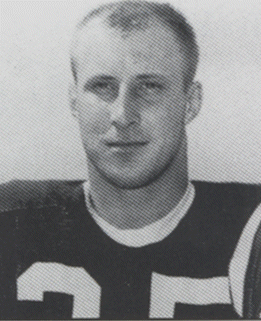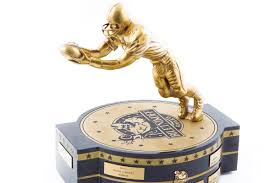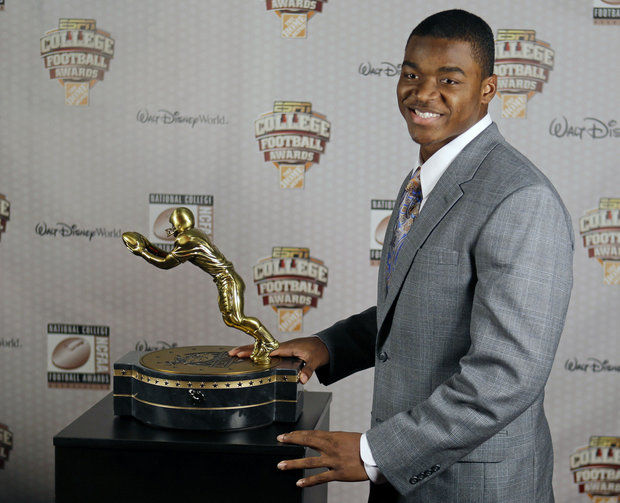The pastime of kicking around a ball pre-dates recorded history. Ancient savage tribes played a form of primitive football. About 2500 years ago, Corinthians, Spartans, and Athenians enjoyed a ball-kicking game which the Greeks named episkuros. The Romans competed in a similar game termed harpastum which they transported west when they invaded the British Isles in the First Century, B.C. The game known in the United States as football derives its existence from the English game of rugby.
 Football was played informally on college lawns in the middle decades of the 19th Century and an annual freshman-sophomore series of "scrimmages" began at Yale in 1840. It was not unitl November, 1869, however, that the first formal intercollegiate football game was played - at New Brunswick, N.J., the Rutgers side defeated Princeton 6 goals to 4. The first professional game was played in 1895 at Latrobe, Pennsylvania. The National Football League was founded in 1921 and merged in 1949 with the All-American Conference and in 1970 with the American Football League.
Football was played informally on college lawns in the middle decades of the 19th Century and an annual freshman-sophomore series of "scrimmages" began at Yale in 1840. It was not unitl November, 1869, however, that the first formal intercollegiate football game was played - at New Brunswick, N.J., the Rutgers side defeated Princeton 6 goals to 4. The first professional game was played in 1895 at Latrobe, Pennsylvania. The National Football League was founded in 1921 and merged in 1949 with the All-American Conference and in 1970 with the American Football League.
In the early days of college fooball, games were played with 25, 20, 15, or 11 men on a side. That varying number of players was standardized to 11 through the efforts of Yales's Walter Camp at the 1880 football convention. A year earlier, the same Camp was involved in the first recorded forward pass in college football. During the Yale-Princeton game, as he was being tackled, Camp threw a football forward to the Elis' Oliver Thompson who sprinted to a touchdown. The Tigers of Princeton pretested; by tossing a coin, the referee made his decision to allw the touchdown.
It was John Heisman who convinced the Football Rules Commitee to legalize the forward pass. For thirty-six years, Heisman coached at a number of schools including Auburn, Clemson, Georgia Tech, Pennsylvania, Washington and Jefferson, and Rice. He, Alonzo Stagg, and Pop Warner, three of the greatest coaches from the turn of the century through the 1920's, constitued the "football Trinity".
Heisman first witnessed a forward pass in 1895 when he scouted a game between North Carolina and Georgia. In order to avoid a blocked punt by onrushing linemen, the Tar
Heel punter passed the ball downfield to a teammate who caught it and ran 70 yards for the only touchdown of the game. In response to the Bulldogs' howls of protest, the referee admitted, "I didn't see the ball thrown," thereby allowing an illegal play.
Heisman envisaged the forward pass as the salvation of a sport which had degenerated into dangerous formations and tactics such as the flying wedge and mass plays. After unsuccessfully attempting for 3 years to convince Rules Chairman Walter Camp to legalize the forward pass, Heisman enlisted the valuable support of committee members John Bell and Paul Dashiell instead. Finally, in 1906, the Rules Committee, college football's governing body, legalized the forward pass. The allowance of the forward pass became the most important development in football since Camp's introduction of scrimmage, the system of downs, and the modern scoring system. The turning away from the unimaginative and brutal mass attack and, instead, toward the open, fast-striking offense with the pass as a weapon appealed to players and spectators alike.
Nonetheless, for the next seven years the pass was rarely used. Then, in 1913, Notre Dame, through the athletic prowess Gus Dorais and Knute Rockne, employed the forward pass with substantial success against the United States Military Academy team. After that game, the forward pass occupied a prominent position in offensive stategy. Heisman, Camp, and Rockne would all later be inducted into the College Football Hall of Fame.
The throw...the catch...the legal reception. Without the receiver there cannot be a successful pass play. A partial listing of great receivers could very well include Don Hutson, Elroy "Crazy Legs" Hirsh, Tom Fears, Dante Lavelli, Raymond Berry, Tommy McDonald, Bobby Mitchell, Lenny Moore, Don Maynard, Paul Warfield, Lionel Taylor, Lance Alworth, Charley Taylor, Johnny Rodgers, Stanley Morgan, Wes Chandler, Lynn Swann, Steve largent, James Lofton, Art Monk, Irving Fryer, and Jerry Rice.
Several of the receivers as college players, including Hirsch, McDonald, Mitchell, Moore, Allworth, Taylor, and Rodgers, were often set in formation as halfbacks or wingbacks - not split from scrimmage.
What of tight-ends who were great receivers? Again, a partial listing could include Mike Ditka, John Mackey, Raymond Chester, David Casper, Kellen Winslow, Tod Christensen, and Ozzie Newsome.
These receivers had different styles and statures. Some were sprinters, some had remarkable "hands", some ran patterns as precise as an ice skater's compulsory figures. What they had in common was the self-discipline, leadership by example, and a commitment to athletic excellence. From these observations, The Tallahassee Quarterback Club Foundation selection committee determined eligibility for the national collegiate receiver award. A candidate must:
1) Be a player who receives a pass and actively plays at an NCAA Division 1-A school.
2) Display leadership and self-discipline; and have a significant, positive impact on his team's success.
3) Display a commitment to be the best player he can be.
The last Two criteria naturally remind football pundits of one great receiver, a player whose receiving skills led to his being described as the consummate receiver - College and Professional Hall of Famer Fred Biletnikoff.
It is small wonder that former Raider coach John Madden empahatically remarked: "Fred tops my list of all-time great receivers."
Fred, a Florida State University All-American receiver, responded enthusiastically to the creation of the award bearing his name by the foundation, "I am honored to have such a prestigious award bear my name." He continued, " I am privileged that my past achievements on the field now are represented by an award that will recognize talented young college football receivers and benefit youth services and scholarships."
Biletnikoff, who played high school football at Tech Memorial in Erie, Pennsylvania, wore number 25 on his jersey during his playing days with the Oakland Raiders. He played for the Montreal Alouettes of the Canadian Football Leaques after his Raider playing career. At Tech Memorial, Fred earned letters in baseball and basketball (All-City Honors) and was a champion high jumper in track and field.
Fred has served as a coach or consultant with the Oakland Raiders since 1989 and is presently the wide receivers coach. He and his wife Angela reside in Danville, California, with their daughter Dacia.



 Football was played informally on college lawns in the middle decades of the 19th Century and an annual freshman-sophomore series of "scrimmages" began at Yale in 1840. It was not unitl November, 1869, however, that the first formal intercollegiate football game was played - at New Brunswick, N.J., the Rutgers side defeated Princeton 6 goals to 4. The first professional game was played in 1895 at Latrobe, Pennsylvania. The National Football League was founded in 1921 and merged in 1949 with the All-American Conference and in 1970 with the American Football League.
Football was played informally on college lawns in the middle decades of the 19th Century and an annual freshman-sophomore series of "scrimmages" began at Yale in 1840. It was not unitl November, 1869, however, that the first formal intercollegiate football game was played - at New Brunswick, N.J., the Rutgers side defeated Princeton 6 goals to 4. The first professional game was played in 1895 at Latrobe, Pennsylvania. The National Football League was founded in 1921 and merged in 1949 with the All-American Conference and in 1970 with the American Football League.